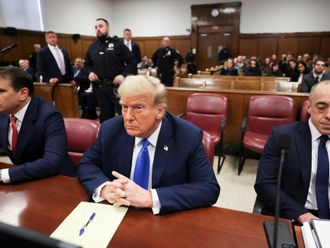Wiretaps on Americans in foreign intelligence investigations are not easy to get. And if you’re a candidate for president, it’s even harder.
That’s the experience of current and former senior US officials who on Saturday expressed disbelief at President Donald Trump’s accusation — levelled without any evidence — that President Barack Obama had him wiretapped at Trump Tower before the November election.
Senior officials, who spoke on the condition of anonymity because such matters are classified, said that there had been no wiretap on Trump.
Under the law governing foreign-intelligence surveillance inside the US, a Federal Bureau of Investigation (FBI) agent would need to show a federal judge that there is probable cause that the target is an “agent of a foreign power” — and that requires more than just talking to, say, the Russian ambassador.
“Both criminal and foreign intelligence wiretaps have onerous and strict processes of approval that require not only multiple levels of internal Justice Department review, but also require court review and approval,” said Matthew Waxman, an expert on national security law at Columbia University.
The law authorising wiretaps in terrorism and espionage cases is known as the Foreign Intelligence Surveillance Act (Fisa) of 1978, passed out of reforms recommended by the Church Committee in the wake of spying abuses by the FBI and the National Security Agency.
The law bars targeted electronic surveillance on US soil unless the government can show that the target was a foreign power or an agent of a foreign power, and that the “facility” — the phone number or email address in question — is being used by the foreign power or agent.
The law authorising criminal intercepts — in cases such as murder, drug dealing or racketeering — is Title III of the Omnibus Crime Control and Safe Streets Act of 1968. Like Fisa, the law requires probable cause, but in this instance that the target is about to or has committed a crime.
In a national security case, the FBI working with attorneys in the Justice Department’s National Security Division prepare a declaration laying out their grounds for seeking a FISA order. A senior intelligence official, typically the FBI or Central Intelligence Agency (CIA) director, must certify that the purpose is to collect foreign intelligence and that the information cannot be obtained by normal investigative means.
Then the package must be approved by a senior Justice official. Only three have authority to approve the order: the attorney general, the deputy attorney general and the head of the National Security Division (NSD).
An NSD attorney would then present the application to a judge of the special Foreign Intelligence Surveillance Court, made up of 11 federal district judges appointed by the chief justice of the United States. They sit in rotation, one judge at a time, typically for a week. The court’s proceedings are highly classified, and generally the court hears only the government’s side of the case.
Following the revelations of widespread NSA surveillance by former intelligence contractor Edward Snowden, Congress in 2015 created an “amicus curiae,” or public advocate, whom the judge can ask to weigh in on significant interpretations of Fisa.
Fisa orders are rarely rejected, in part because lawyers will withdraw or amend an order if a judge signals it will not pass muster. Once approved, the order is served on the phone or internet company that handles the number or email address in question.
On average, in recent years, there have been about 1,400 to 2,300 Fisa orders a year. Each order can contain multiple names and numbers or email addresses.
In a criminal case, a federal prosecutor goes before a federal magistrate and presents an application for a “Title III” order. In 2015, according to the Administrative Office of the US Courts, there were 1,400 wiretap orders, covering one or more devices. Some experts, however, citing phone company transparency reports, say the office’s number appears low.
In the old days, FBI agents would attach alligator clips to phone lines. Today, a technician at a phone company will type into a computer system the number or email address, digitally creating another line that goes to an FBI listening post. The FBI has separate facilities for criminal wiretaps and national security intercepts. The latter are generally recorded for transcription. Criminal wiretaps are listened to in real time.
Under Title III, if an agent hears a target talking to someone not involved in the crime — like a pizza deliverer, he or she is required to hang up.
Under Fisa, any information that does not have “foreign intelligence” value must be “minimised” or masked in the transcript. That includes the names of US citizens who are picked up speaking to the target unless their identities are relevant to understanding the foreign intelligence.
In a typical counter-intelligence investigation, if an agent is trying to figure out a target’s network, conversations — even those that might appear innocuous at first — are more likely to be considered relevant. Thus the minimisation rules for national-security wiretaps are more lenient than those for criminal wiretaps because spies and terrorists generally use more sophisticated tradecraft to evade surveillance.
The communications of people who are speaking to the target are termed “incidental.” The FBI, for instance, routinely wiretaps the foreign embassies of major adversaries such as China and Russia — including intercepting the cell phone conversations of senior diplomats. Anyone speaking to any of these targets would have their conversations picked up as incidental collection.
It is possible, some former officials said, that there may be recordings of phone conversations between someone in Trump Tower and a Russian official or officials. If so, the most likely explanation is that the surveillance was being conducted on the Russian officials, who historically have been under court-authorised Fisa surveillance.
Those talking to the target would have had their conversations picked up as incidental collection.












